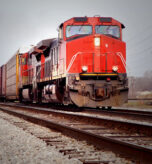Introduction
Modern industrial facilities face increasingly complex rail logistics challenges that can significantly impact operational efficiency and bottom-line results. This case study examines how our team transformed rail operations at a major industrial facility through advanced supply chain technology solutions. The facility’s operations depended heavily on rail service for both inbound raw materials and outbound finished products, with minimal on-site storage capacity and complex coordination requirements between multiple stakeholders. PraxiChain’s comprehensive solution addressed critical needs through real-time visibility, predictive analytics, and automated coordination systems. By implementing cutting-edge technology and leveraging deep supply chain expertise, PraxiChain helped the facility overcome significant operational challenges and achieve measurable improvements in efficiency, reliability, and cost management.
At A Glance
PraxiChain’s industrial rail operations solution delivered:
- Deep supply chain expertise demonstrated through successful implementation of integrated rail logistics systems spanning multiple carriers, local switching operations, and facility operations
- Proven ability to deliver measurable results with 40% reduction in rail car dwell time and 25% reduction in buffer inventory requirements
- Industry-leading technology deployment including real-time tracking, predictive analytics, and automated coordination systems
The Challenge
The industrial facility faced critical operational challenges that threatened production efficiency and reliability. Their track design could only accommodate daily rail car requirements, making operations vulnerable to service disruptions. Weekend and holiday periods without local switching service created significant operational risks that required careful management and contingency planning.
Key operational challenges included inconsistent Class 1 railroad service affecting production continuity, limited storage capacity requiring precise coordination of rail car movements, and complex switching operations involving multiple partners. The facility also lacked real-time visibility into rail car location and status, hampering their ability to respond quickly to disruptions.
Additional complications arose from weather-related delays, variable transit times, and the need to coordinate multiple inbound raw material shipments with outbound finished product movements. These challenges were amplified by the facility’s minimal on-site storage capacity and dependence on reliable rail service for continuous operations.
PraxiChain Solution
- Implemented comprehensive real-time rail car tracking and visibility system integrated with local switch carrier and Class 1 railroad systems
- Deployed predictive analytics engine to forecast arrival times and potential service disruptions
- Created automated switching schedule optimization incorporating operational constraints
- Developed dynamic storage management system coordinating lease track utilization
- Installed IoT sensors for monitoring car conditions and product status
- Built automated alert system for schedule deviations and threshold violations
- Established contingency planning protocols for service disruptions
- Integrated weather monitoring and impact prediction capabilities
- Created automated reporting and analytics dashboard for management oversight
Results
PraxiChain’s implementation delivered significant, measurable improvements to rail operations across multiple key performance indicators. The solution enabled a 40% reduction in rail car dwell time through optimized switching schedules and improved coordination between stakeholders. Real-time visibility and predictive analytics helped reduce buffer inventory requirements by 25% while maintaining production reliability.
The system’s automated coordination capabilities reduced manual planning effort by 60% and virtually eliminated switching errors. This improved efficiency translated directly to cost savings and improved resource utilization throughout the operation. The platform’s contingency planning capabilities proved particularly valuable during weather-related disruptions, enabling rapid response and maintaining operational continuity.
Integration with local and Class 1 railroad systems provided unprecedented visibility into car movements and enabled proactive issue resolution before problems could impact production. The implementation transformed the facility’s rail operations from a potential bottleneck into a strategic advantage, supporting production targets while optimizing resource utilization and reducing operational costs.






